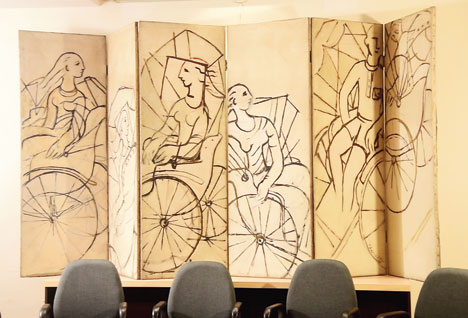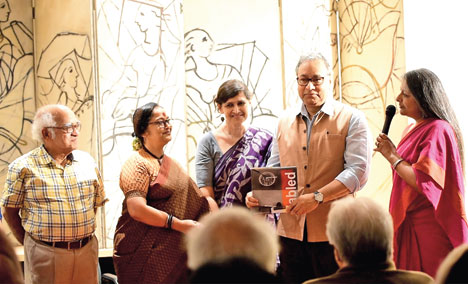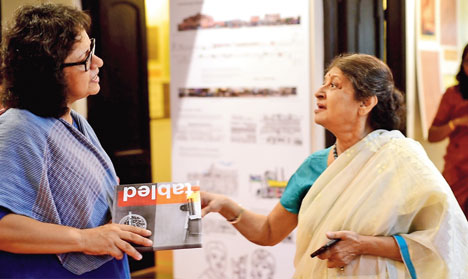
Calcutta:
One of the recipes that she had created was named Chicken Beparwah.
Shanu Lahiri, painter and sculptor, cooked with as much passion as she brought to her art. Wherever she was, laughter and conversation would flow. So would food cooked by her, as unusual and robust as her.
She would often name them with care.

Jawhar Sircar and Nandita Palchaudhuri at the launch of Tabled
The warmth and generosity of those afternoons and evenings that she presided over at her Lake Town home seemed to flow directly into the auditorium at Jadunath Bhavan in the city last Friday, at the launch of Tabled, a compilation of Shanu Lahiri’s recipes, anecdotes and art.
Shanu Lahiri, a member of The Group, a women’s artists’ collective in the city, was the sculptor of Paroma, a Calcutta landmark that had been installed in 1987 on what came to be known as the Science City island. The city woke up on a November morning in 2014 to find the statue, a woman’s form with children, vanished and replaced by the multi-colour globe of the Bengal government’s Biswa Bangla brand.

The book, launched by Jawhar Sircar, chairperson, Centre for Studies in Social Sciences, is the labour of love of Damayanti Lahiri, Shanu’s daughter. Damayanti, however, pointed at her namesake, Damayanti Basu Singh of Vikalp publishers, as having played a more important role in the project.
Tabled has been designed and structured by artist Chittrovanu Mazumdar, who happens to be Shanu Lahiri’s nephew, and who refused to show up on the stage despite several calls, remaining doggedly in the background.
The black and white cover of Tabled does not quite prepare one for what lies within: an explosion of colours, forms and recipes. But that was Shanu Lahiri. Close friends and loved ones remembered her lovingly.
Historian Tapati Guha Thakurta, who grew up in the south Calcutta house where the artist first lived with her family before moving to Lake Town, chose to speak in Bengali. “The language of “Shanu mashi’s” art was international, but the language she wrote in, or that of her inner self, was Bengali,” said Guha Thakurta. All those conversations that Shanu Lahiri seemed to be always having were conducted in Bengali. Guha Thakurta spoke about Shanu Lahiri’s food-loving husband, without whose large and benign influence the artist would not have grown; neither would the eccentric cook have been born.
TV personality Chaitali Dasgupta, who had interviewed Shanu Lahiri for a cooking programme on Doordarshan, said the sculptor had refused to put on the slightest make-up for the shoot. “Let the sweat show. It will look like garjan tel, garjan tel,” remembered Dasgupta. The Durga idol’s face is painted with this oil.
When social entrepreneur Nandita Palchoudhuri, who was conducting the conversation, asked scholar Samik Bandyopadhyay about the correspondences between cooking and painting, Bandyopadhyay spoke about “Shanudi’s passion for work as activity”. “Her lines move madly,” he said. She painted as if without a desire to control. “There was a kind of continuum in the ways she lived, worked and cooked.”
It is probably not a coincidence that when he received Shanu Lahiri’s book, Bandyopadhyay chanced upon a newspaper article on an exhibition in Barcelona on works by Picasso that are about cooking and utensils.
The evening evoked memories of a time that is difficult to imagine now: a flow of spirit over conversation and food, without the interruption, or aid, of mobile phones, ordering food from outside, and in the Bengali language. The previous city has disappeared, as the missing statue of Paroma proves.
source: http://www.telegraphindia.com / The Telegraph,Calcutta,India / Home> Calcutta / by Chandrima S Bhattacharya / June 15th, 2018